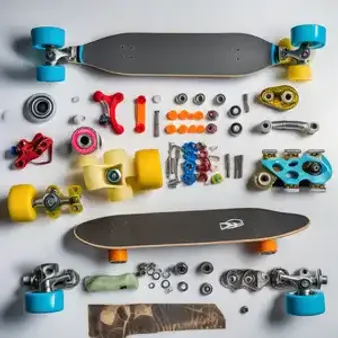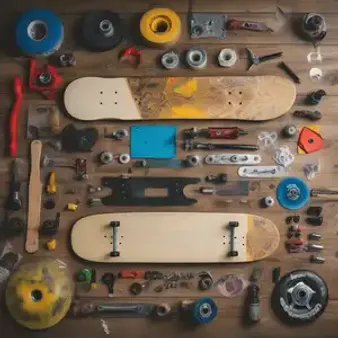Table of Contents
Picking the right skateboard setup for beginners can be exciting and maybe a little confusing! At kizworld, we're here to break down everything you need for an awesome skateboarding experience. Whether you're dreaming of landing ollies or just cruising around, this guide will walk you through all the essentials for your first skateboard setup.
Component | Beginner Recommendations |
|---|---|
Deck | 7.75" - 8.25" width |
Trucks | Size matching deck width, durable material |
Wheels | 52mm - 56mm diameter, 99A - 101A hardness |
Bearings | ABEC 5 or higher for smooth rolling |
Choosing the Right Skateboard Setup for Beginners
Deck the Halls (or at Least Your Skateboard)
Picking your first skateboard is like choosing your trusty sidekick! You want one that's the right size and feels good. Most beginner boards are between 7.75" and 8.25" wide. A wider board gives you more room for balance, which is super important when you're just starting out. Think of it like learning to ride a bike with training wheels - a wider deck is like having extra support to keep you steady. Don't worry about getting too fancy with shapes or designs yet, just focus on finding a board that feels comfortable and manageable for you.
Truckin' Along: Choosing the Right Trucks
Trucks are like the legs of your skateboard, connecting the wheels to the deck. For beginners, it's best to choose trucks that are durable and match the width of your deck. You don't want your trucks sticking out too far or feeling too narrow! Imagine trying to balance on a seesaw that's way too wide or too skinny – not very easy, right? Picking the right size trucks will help your board feel balanced and stable. They come in different materials too, and for starting out, a good quality aluminum truck is perfect.
Component | Description |
|---|---|
Deck | The flat part you stand on |
Trucks | Metal parts that connect wheels to the deck |
Wheels | Round and made of polyurethane for rolling |
- Choose a deck width that feels comfortable for your balance.
- Select trucks that match your deck width for stability.
- Start with durable aluminum trucks as a beginner.
Essential Components of a Beginner Skateboard Setup
Deck the Halls (or at Least Your Skateboard)
Picking your first skateboard is like choosing your trusty sidekick! You want one that’s the right size and feels good. Most beginner boards are between 7.75" and 8.25" wide. A wider board gives you more room for balance, which is super important when you’re just starting out. Think of it like learning to ride a bike with training wheels – a wider deck is like having extra support to keep you steady. Don’t worry about getting too fancy with shapes or designs yet, just focus on finding a board that feels comfortable and manageable for you.
Truckin’ Along: Choosing the Right Trucks
Trucks are like the legs of your skateboard, connecting the wheels to the deck. For beginners, it’s best to choose trucks that are durable and match the width of your deck. You don’t want your trucks sticking out too far or feeling too narrow! Imagine trying to balance on a seesaw that’s way too wide or too skinny – not very easy, right? Picking the right size trucks will help your board feel balanced and stable. They come in different materials too, and for starting out, a good quality aluminum truck is perfect.
Component | Description |
|---|---|
Deck | The flat part you stand on |
Trucks | Metal parts that connect wheels to the deck |
Wheels | Round and made of polyurethane for rolling |
Now, let's talk wheels! For a beginner skateboarding for beginners, you'll want wheels that are a good size for learning tricks and cruising around. Look for wheels that are between 52mm and 56mm in diameter. The diameter is how tall the wheel is. A bigger diameter means a faster roll, but it can be a little tougher to learn tricks on. You'll also see something called "durometer" on the wheels. This refers to how hard the wheels are. For beginners, a durometer between 99A and 101A is a good choice. It'll give you a smooth ride without being too slippery.
Last but not least, we have bearings! Bearings are like tiny little wheels inside your wheels that let them spin really smoothly. They're rated by something called an ABEC rating. The higher the ABEC rating, the faster and smoother your bearings will be. For a beginner, ABEC 5 or higher is a good starting point. You don't need super-fast bearings when you are just learning, and good quality bearings at this rating will keep you rolling smoothly while you practice. To make it easy, think of bearings like this: they're like the oil in a car engine, the better the oil, the smoother the ride!
- Choose a deck width that feels comfortable for your balance.
- Select trucks that match your deck width for stability.
- Start with durable aluminum trucks as a beginner.
Essential Components of a Beginner Skateboard Setup
Assembling Your First Skateboard Setup
Putting a skateboard together is like building a mini-ramp in your backyard – it's exciting to see it all come together! You don't need any special tools, just some basic ones you probably have at home. First, you'll attach the trucks to the deck. Think of the trucks like the feet of the skateboard, and the deck is the body. You'll use bolts and nuts to secure them, making sure they're nice and tight. Next up, you'll slide the bearings into the wheels. These little guys help your wheels spin smoothly, like tiny roller coasters inside your wheels! Once the bearings are in, pop those wheels onto the trucks, and you're almost ready to roll.
- Choose a deck width that feels comfortable for your balance.
- Select trucks that match your deck width for stability.
- Start with durable aluminum trucks as a beginner.
Assembling Your First Skateboard Setup
Skateboard Setup Tips for Beginners
Alright, so you've got all your awesome skateboard parts ready – congrats! Now it's time for the fun part: putting it all together! Remember those trucks we talked about, the ones that are like the feet of your board? Make sure they're screwed onto the deck nice and tight, like when you tie your shoelaces super snug before a race. And don't forget the grip tape! That's the sandpapery stuff on top of the deck that helps your shoes grip the board. It's like magic that keeps you from slipping and sliding all over the place. You can find skateboarding for beginners guide helpful.
Step | Description |
|---|---|
Attach Trucks | Securely fasten trucks to the deck using bolts and nuts. |
Apply Grip Tape | Carefully apply grip tape to the deck's top surface for traction. |
When you're first starting out, it's a good idea to keep your trucks a little loose. This will make turning easier while you're getting the hang of things. Imagine trying to steer a shopping cart with a really stiff handle - way too hard, right? As you get more comfortable, you can tighten them up for more stability and control. And hey, don't be afraid to ask a friend who skates or even someone at a skate shop to give you a hand with setting up your board. They're usually super cool about sharing tips and tricks!
- Keep trucks slightly loose initially for easier turning.
- Tighten trucks gradually as comfort and skill improve.
- Seek assistance from experienced skaters or skate shop staff for setup guidance.
Skateboard Setup Tips for Beginners
Final Thought
Getting started with skateboarding is an exciting journey, and having the right setup is the first step to an amazing experience. Remember to choose components that match your skill level and riding style, prioritize safety gear, and most importantly, have fun learning and progressing on your skateboard!